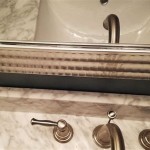How To Install A Bathroom Sink Shut-Off Valve
Installing a new shut-off valve for a bathroom sink is a common plumbing task that can be accomplished by a homeowner with basic plumbing knowledge and the right tools. Shut-off valves, also known as stop valves, are crucial components in a plumbing system. They allow water supply to be isolated at specific fixtures, facilitating repairs or replacements without shutting off water to the entire building. Replacing old or malfunctioning valves is often necessary, and knowing how to properly install a new one is a valuable skill.
This article provides a comprehensive guide to installing a new shut-off valve under a bathroom sink. It outlines the necessary tools and materials, details the step-by-step process, and offers important safety precautions to ensure a successful and leak-free installation.
Key Point 1: Preparation and Safety
Before commencing any plumbing work, thorough preparation is paramount. This involves gathering the necessary tools and materials, understanding the existing plumbing configuration, and taking essential safety measures.
The following tools and materials are typically required for a standard shut-off valve installation:
*New Shut-Off Valve(s): Choose a valve compatible with the existing pipe material (copper, PEX, or CPVC) and pipe size. Angle stops are common for bathroom sinks, allowing the supply line to connect at a 90-degree angle. Straight stops are also available.
*Pipe Cutter: A tubing cutter is essential for cleanly cutting copper pipes. For PEX or CPVC, specialized cutters are required.
*Deburring Tool or File: Used to remove burrs from the cut pipe end, ensuring a smooth surface for connecting the valve.
*Two Adjustable Wrenches: Used to tighten and loosen fittings. Having two wrenches prevents twisting the pipes during tightening.
*Teflon Tape (Plumber's Tape): Used to seal threaded connections and prevent leaks.
*Penetrating Oil (Optional): Useful for loosening stubborn compression fittings.
*Bucket and Towels: To catch any residual water and clean up spills.
*Flashlight: To provide adequate lighting under the sink.
*Safety Glasses: To protect eyes from debris.
*Work Gloves: To protect hands.
Prior to beginning the installation, several safety precautions should be taken. First and foremost, the main water supply to the house must be turned off. This is typically done at the water meter or a main shut-off valve located near where the water enters the building. After turning off the main water supply, open the faucet on the bathroom sink to relieve any remaining pressure in the pipes. Place a bucket underneath the existing shut-off valve to catch any remaining water in the lines. It's also advisable to wear safety glasses and work gloves throughout the process.
Inspect the existing plumbing under the sink. Identify the pipe material (copper, PEX, or CPVC) and the type of connection used (compression fitting, solder joint, or push-fit). Understanding the existing plumbing will dictate the appropriate valve type and installation method.
Key Point 2: Removing the Old Valve
The method for removing the old shut-off valve depends on the type of connection used. Compression fittings, solder joints, and push-fit fittings each require a distinct approach.
Removing a Compression Fitting:
Compression fittings are a common type of connection for shut-off valves. To remove a valve connected with a compression fitting, use two adjustable wrenches. Place one wrench on the valve body and the other on the compression nut. Turn the nut counterclockwise to loosen it. If the nut is difficult to loosen, apply penetrating oil and allow it to soak for a few minutes. Once the nut is loose, carefully slide it along the pipe, followed by the compression ring (ferrule). The valve can then be pulled away from the pipe. Be prepared for residual water to drain from the pipe.
Removing a Soldered Valve:
Removing a soldered valve requires more skill and potentially specialized tools. Soldered connections are permanent, so the pipe must be cut to remove the valve. Use a pipe cutter to cut the copper pipe a short distance upstream from the valve. Leave enough pipe exposed to allow for the installation of the new valve. After cutting the pipe, use a deburring tool or file to remove any burrs or sharp edges from the cut end. This ensures a smooth and even surface for the new connection.
Removing a Push-Fit Valve:
Push-fit connections, such as those made by SharkBite fittings, are relatively easy to remove. Most push-fit valves require a release tool to disengage the valve from the pipe. Insert the release tool around the pipe and push it firmly against the valve body. While holding the release tool in place, pull the valve away from the pipe. If a release tool is not available, some push-fit fittings can be removed by pushing the valve towards the pipe and then pulling it off while twisting. Be sure to consult the manufacturer's instructions for the specific push-fit fitting being used.
After removing the old valve, inspect the pipe for any damage or corrosion. If the pipe is damaged, it may need to be repaired or replaced before installing the new valve. Clean the pipe end thoroughly to remove any debris or old sealant.
Key Point 3: Installing the New Valve
Installing the new shut-off valve requires careful attention to detail to ensure a secure and leak-free connection. The installation method depends on the type of valve and the existing pipe material.
Installing a Compression Fitting Valve:
Before installing a compression fitting valve, ensure that the pipe end is clean and free of burrs. Slide the compression nut onto the pipe, followed by the compression ring (ferrule). Insert the pipe into the valve body until it is fully seated. Tighten the compression nut onto the valve body using two adjustable wrenches. Hold the valve body with one wrench and tighten the nut with the other. Tighten the nut until it is snug, but avoid over-tightening, which can damage the compression ring or the valve body. A quarter to half turn past hand tight is usually sufficient. After tightening, inspect the connection for any signs of leaks.
Installing a Solder Valve:
Soldering a valve requires experience and skill in soldering copper pipes. This process involves cleaning the pipe and valve surfaces, applying flux, heating the joint with a torch, and melting solder into the joint. Due to the complexity and potential fire hazard, it is recommended that homeowners without soldering experience hire a licensed plumber to install a solder valve. Proper ventilation is essential when soldering to avoid inhaling harmful fumes. Allow the joint to cool completely before turning on the water supply.
Installing a Push-Fit Valve:
Push-fit valves are relatively easy to install and require no special tools (other than a pipe cutter). Ensure that the pipe end is clean, deburred, and free of any debris. Mark the insertion depth on the pipe according to the manufacturer's instructions. Insert the pipe into the valve until it reaches the marked depth. The valve should click or snap into place, indicating a secure connection. Tug on the valve to ensure that it is properly seated. If the valve does not seat properly, remove it and inspect the pipe end for any obstructions. Be sure to follow the manufacturer's instructions carefully to ensure a proper and leak-free installation.
Final Steps:
After installing the new shut-off valve, slowly turn on the main water supply to the house. Carefully inspect the valve and all connections for any signs of leaks. If any leaks are detected, immediately turn off the water supply and tighten the connections further. If the leaks persist, the valve or the connections may need to be re-evaluated and potentially replaced. Once all leaks are resolved, test the valve by turning it on and off several times to ensure that it functions properly. Finally, clean up the work area and dispose of any waste materials properly.
Regular maintenance of shut-off valves is essential to ensure their proper functioning. Periodically turn the valves on and off to prevent them from seizing up due to mineral build-up. If a valve becomes difficult to turn, apply penetrating oil to the valve stem and allow it to soak for a few minutes. If the valve continues to be difficult to turn, it may need to be replaced. By following these guidelines and taking appropriate safety precautions, installing a bathroom sink shut-off valve can be a straightforward and rewarding DIY plumbing project.

How To Install Water Shut Off Valve For Sinks

How To Install A New Bathroom Water Supply Shutoff Valve

How To Install A Water Shut Off Valve 9 Minutes Home Repair Tutor

Handle Broke Off On Shut Valve Under Sink Diy Plumbing Repair Bathroom

How To Replace A Shutoff Valve Diy Family Handyman

How To Sweat On A Valve Water Installation

How To Install Shutoff Valves The Home Depot Plumbing Tips

How To Replace A Leaking Shutoff Valve Under Sink

Install Shut Off Valve Under Sink Replace Faucet Mobile Home Repair

How To Repair A Leaking Sink Shut Off Valve Doityourself Com
Related Posts







